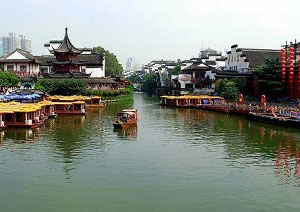
Confucius Temple and Qinhuai scenery
 Nanjing Confucius Temple is for consecrating and worshipping Confucius, the great thinker and educator of ancient China. The Confucius Temple (Fuzimiao) was originally built during the Song Dynasty and is situated on the north bank of the Qinhuai River. The Song Dynasty was a period of great Confucian revivalism and the temple here is considered to be one of the best preserved of its type in China. During the Ming Dynasty the temple was expanded and became a school for children of the imperial court. The buildings on both sides of the Temple which are now small tourist shops were once individual study rooms for Confucian scholars.
Nanjing Confucius Temple is for consecrating and worshipping Confucius, the great thinker and educator of ancient China. The Confucius Temple (Fuzimiao) was originally built during the Song Dynasty and is situated on the north bank of the Qinhuai River. The Song Dynasty was a period of great Confucian revivalism and the temple here is considered to be one of the best preserved of its type in China. During the Ming Dynasty the temple was expanded and became a school for children of the imperial court. The buildings on both sides of the Temple which are now small tourist shops were once individual study rooms for Confucian scholars.
 The Spirit Valley Temple is situated on the Dulong Hillock on the left of the Purple Mountain in the northeastern suburb of Nanjing. The temple originally lay before the Wanzhu Peak south of the Purple Mountain. In the Liang Dynasty Buddhist Master Baozhi was buried here. It was named "Baogong Monastery" in the Tang Dynasty, Kaishan Monastery in the Later Tang Dynasty, Taiping Xingguo Temple in the Song Dynasty, and Jiangshan Temple in the Yuan Dynasty and the beginning of the Ming Dynasty. As the pagoda was too close to the imperial palace, the temple was moved to the present site, renamed "Linggu Temple" and presented with a horizontal board with the inscription of "First Buddhist Monastery ".
The Spirit Valley Temple is situated on the Dulong Hillock on the left of the Purple Mountain in the northeastern suburb of Nanjing. The temple originally lay before the Wanzhu Peak south of the Purple Mountain. In the Liang Dynasty Buddhist Master Baozhi was buried here. It was named "Baogong Monastery" in the Tang Dynasty, Kaishan Monastery in the Later Tang Dynasty, Taiping Xingguo Temple in the Song Dynasty, and Jiangshan Temple in the Yuan Dynasty and the beginning of the Ming Dynasty. As the pagoda was too close to the imperial palace, the temple was moved to the present site, renamed "Linggu Temple" and presented with a horizontal board with the inscription of "First Buddhist Monastery ".
 Qin Huai River, southwest of the city and extending 110 kilometers long, is a branch of Yangtze River. The river was also known as Huaishui in the ancient times. Legends have it that the First Emperor of the Qin Dynasty, in order to eliminate an atmosphere that was presumably conducive to incubating rebels, ordered to have a square hill tunneled and a long ridge broken so that water could pout into the Huaishui, a tributary of the Yangtze River. The Qinhuai River attached people to settle down along itself. The river region had become a distribution and trade center by the Six Dynasties period.
Qin Huai River, southwest of the city and extending 110 kilometers long, is a branch of Yangtze River. The river was also known as Huaishui in the ancient times. Legends have it that the First Emperor of the Qin Dynasty, in order to eliminate an atmosphere that was presumably conducive to incubating rebels, ordered to have a square hill tunneled and a long ridge broken so that water could pout into the Huaishui, a tributary of the Yangtze River. The Qinhuai River attached people to settle down along itself. The river region had become a distribution and trade center by the Six Dynasties period.
South Gate of City Wall (Zhonghuamen)
 The city wall in Nanjing was first constructed in the Southern Tang Dynasty and reconstructed in the Ming Dynasty. The South Gate is the best-preserved part of Nanjing's ancient city walls. Zhonghuamen ("The Castle of China Gate") is the largest gate along the wall and is composed of three towers and four smaller gates inside one another. The gate is now separated from the rest of the wall and is located on a huge traffic island at a busy road junction. The caves built into the structure could hold 3,000 soldiers, making it the most fortified block to ward off aggressive armies. Zhonghuamen Citadel, extending 128 meters long and 118 meters wide, is the biggest of its kind in China.
The city wall in Nanjing was first constructed in the Southern Tang Dynasty and reconstructed in the Ming Dynasty. The South Gate is the best-preserved part of Nanjing's ancient city walls. Zhonghuamen ("The Castle of China Gate") is the largest gate along the wall and is composed of three towers and four smaller gates inside one another. The gate is now separated from the rest of the wall and is located on a huge traffic island at a busy road junction. The caves built into the structure could hold 3,000 soldiers, making it the most fortified block to ward off aggressive armies. Zhonghuamen Citadel, extending 128 meters long and 118 meters wide, is the biggest of its kind in China.
| Nanjing Attractions List | |

